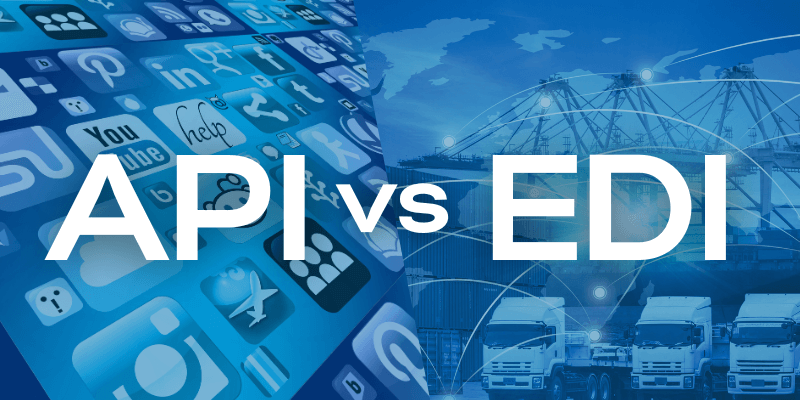Data Exchange in Dock Scheduling Software: The Synergy of EDI and API

Managing complex supply chains is more of a strategy than only execution. While the execution has to be perfect now, with the higher-than-ever customer expectations and fierce competition, it has to be shaped through a robust supply chain and IT strategy. And data has to be the heart of such business strategies.
Within the technological strategies in logistics lie multiple new-age transformations, like yard management and dock scheduling software. However, such software works well only when integrated well with the existing ecosystem of the ERP, WMS, TMS, and other company systems.
Such integration is enabled with the help of data exchange done through Electronic Data Interchange (EDI) and Application Programming Interface (API). While these are supercritical elements of ensuring successful system integrations, they are often overlooked.
Understanding EDI and API-driven Real-Time Data Exchange in Logistics
Before getting into the specifics, we should understand the importance of seamless data exchange and real-time data in logistics. According to IBM, 87% of CSCOs find it challenging to anticipate and manage supply chain issues, and 84% state that a lack of visibility in the supply chain is their biggest challenge.
These challenges can be addressed with the help of EDI and API. With EDI and API, real-time data exchange can be done between systems that help enhance visibility in the supply chain multiple times. With such a real-time visibility boost, managers can immediately act when things start to go out of control. EDI and APIs are the backbone of many more such possibilities in logistics today, ensuring speed, transparency, accuracy, and responsiveness. Let's get a deeper understanding of EDIs and APIs.
EDI and API: A Brief Overview
-
Electronic Data Interchange (EDI): EDI has been the data-sharing "gold standard" between systems and has been the tried-and-tested data exchange method for a long time. EDI provides a common language across platforms, which offers consistent communication between the systems. This helps in eliminating manual errors and reducing manual intervention.
-
Application Programming Interface (API): While EDI establishes a common language, API connects the systems in real-time. APIs allow instant information sharing. Such instant information helps dock scheduling systems to update dynamically, making them incredibly responsive.
So why EDI and API are important for logistics? In logistics, the latest information is the edge. It can be the differentiator between a winning and losing supply chain or between a cost-effective and costly supply chain. Real-time data and insights can help save costs and increase revenues or profits. According to a Gartner, up to 25% reductions in inventory costs can be realized with improved visibility through the supply chain.
Hence, harnessing the power of instant, real-time information through EDI and API should be central to the supply chain system strategy. Let's understand how.
5 Ways to Harness the Power of EDI and API in Dock Scheduling Software
While every strategy can have a different path of execution, here are the top 5 ways to harness EDIs and APIs in dock scheduling.
-
Real-time Updates & Visibility: With APIs, dock scheduling software can sync in real-time, allowing teams to activate plan B swiftly. Whether it's an unexpected delay or a last-minute shipment, the combined power of API and EDI ensures that all stakeholders are updated.
-
Enhanced Accuracy: Manual data entry is always prone to errors. Automating data exchange through EDI removes these potential mistakes, ensuring that the information in the dock scheduling system is accurate and consistent.
-
Streamlined Operations: EDI and API mean less manual intervention. Tasks that took hours before can now be done in seconds. Such massive time saving reduces the overheads and drives efficiency across the board.
-
Improved Decision-Making: Logistics managers can make informed decisions quickly with real-time data at their fingertips. Be it realigning resources or adjusting schedules, it can all be done with the help of data-driven choices.
-
Enhanced Scalability: As businesses grow, so do their logistical needs. Integrating EDI and API ensures dock scheduling systems can scale with the company, quickly adapting to increasing data volumes and complexity.
The Future of Dock Scheduling – Seamless Data Integration
In the future, the demand for real-time, accurate, and efficient data exchange in logistics is bound to grow. Companies that harness the combined power of EDI and API in their dock scheduling software will be better positioned to meet these demands, commanding a competitive edge.
The fusion of EDI and API in dock scheduling means modern, efficient, data-driven logistics operations. As businesses aim to optimize every element of their operations, turning to advanced dock scheduling systems equipped with the power of EDI and API becomes necessary.
Now is the time to invest in these amazing solutions and unlock the potential of data exchange in dock scheduling. Connect with C3 Solutions today to understand more.


